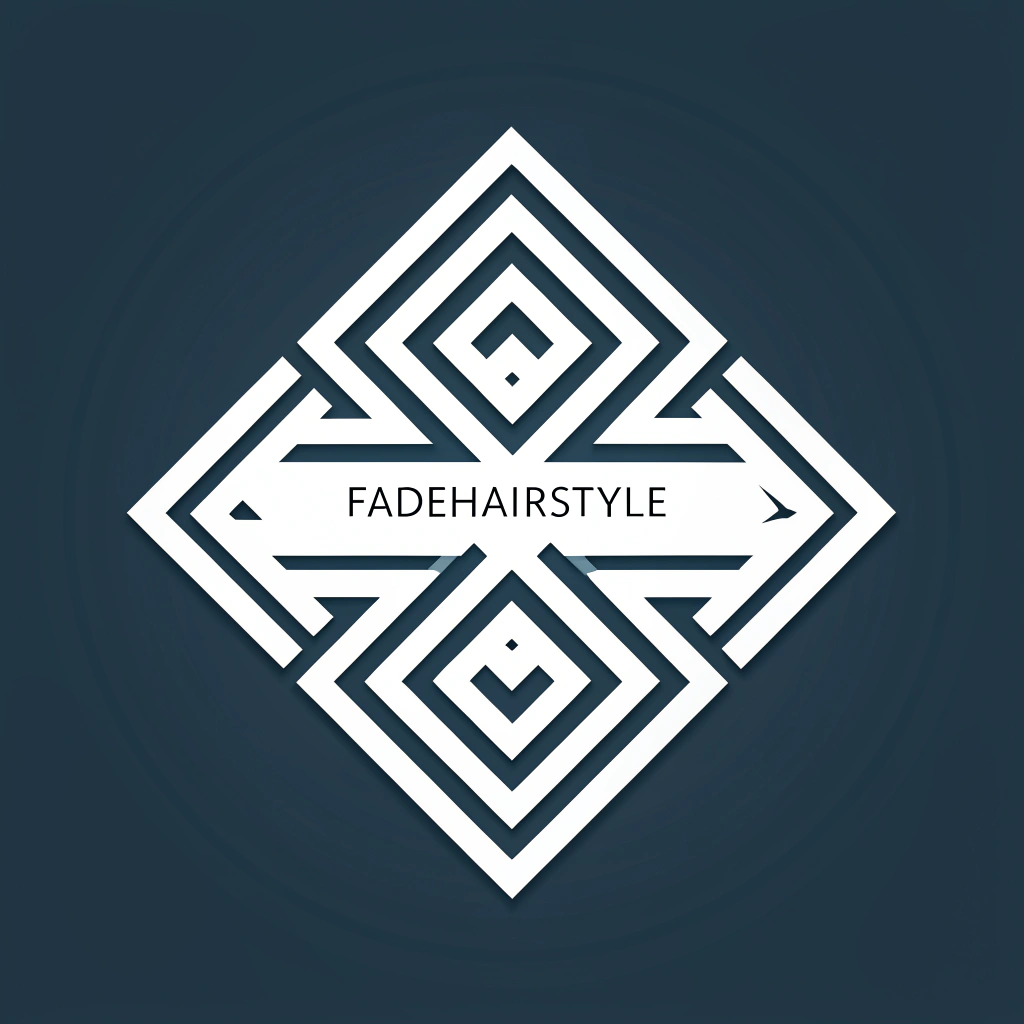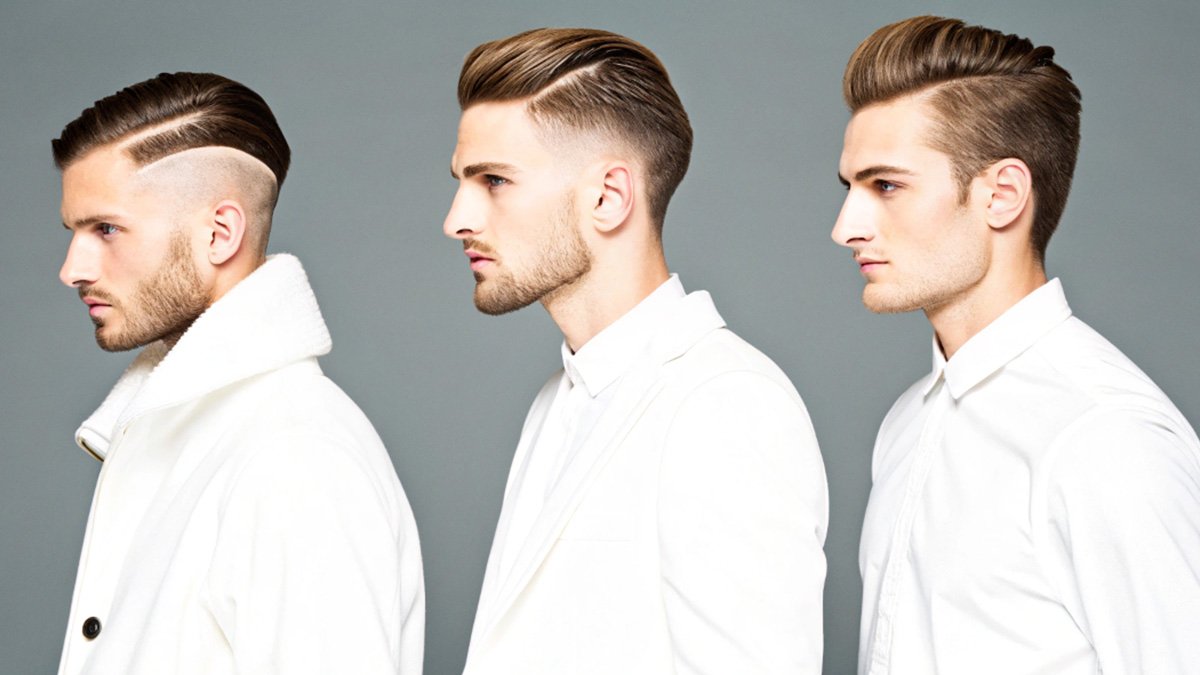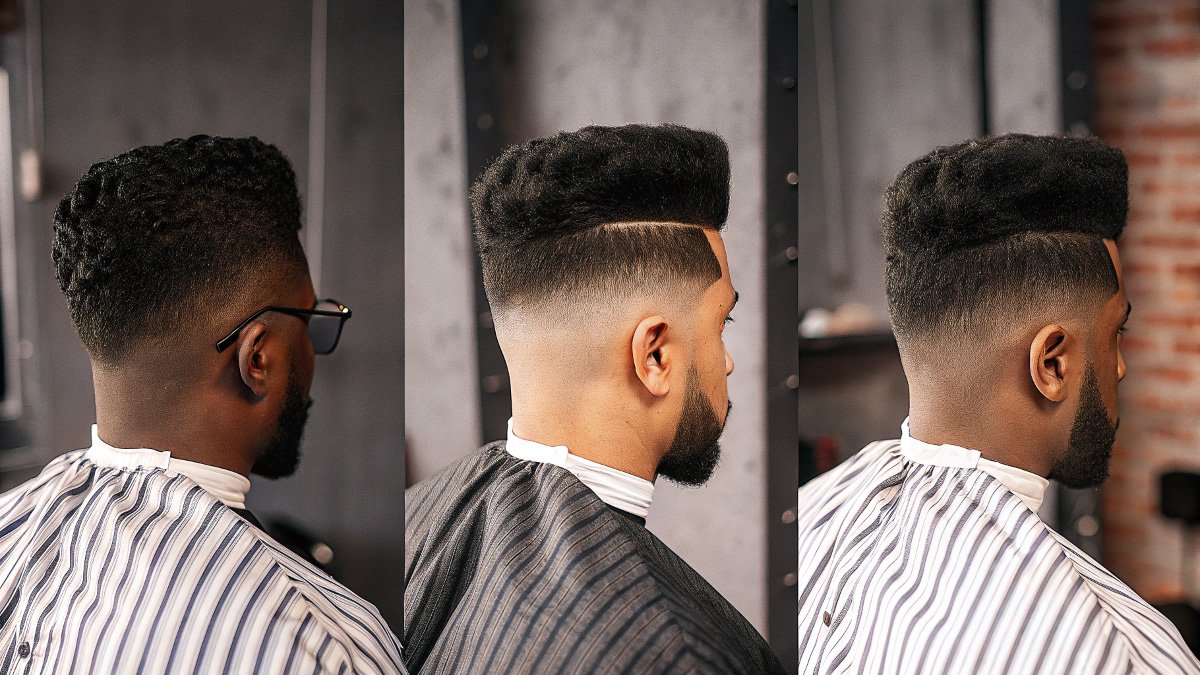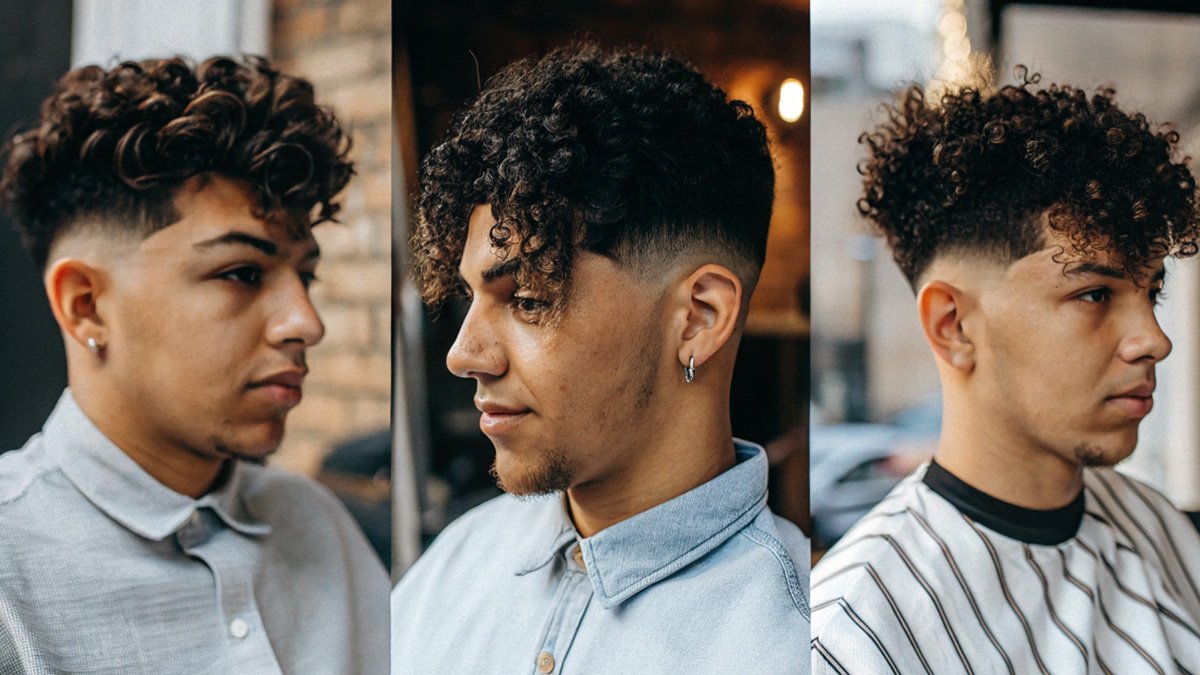The undercut fade represents one of the most versatile and popular men’s haircuts today. This style combines short sides with longer hair on top, creating clean lines that work for professional and casual settings. Men choose this cut for its adaptability and modern appearance.
This comprehensive reference covers everything about undercut fades. You will learn about 17 specific variations, styling methods, maintenance requirements, and expert recommendations. Each section provides practical information to help you achieve and maintain your perfect undercut fade.
Understanding Undercut Fade Fundamentals
Basic Cut Structure
The undercut fade features two distinct hair lengths. Barbers cut the sides and back short using clippers. The top section remains longer, usually cut with scissors. This length difference creates the characteristic contrast that defines the style.
Professional barbers use specific techniques to achieve clean lines. Clippers with guards ranging from #1 to #4 create the short sections. Scissors shape the longer top portion. The fade element blends these sections smoothly.
Proper technique requires skill and precision. Barbers must understand hair growth patterns and head shapes. They adjust cutting angles based on individual characteristics. This customization ensures optimal results for each client.
Fade Classifications
High fades begin near the temple area. This placement creates bold contrast and emphasizes facial features. High fades suit men who want dramatic style statements.
Mid fades start around the middle of the head. This balanced placement works well for most face shapes. Mid fades offer versatility while maintaining the undercut’s distinctive appearance.
Low fades transition near the ears and neckline. This subtle approach suits conservative environments. Low fades require less frequent maintenance than higher variations.
Skin fades blend completely into the scalp. This technique creates the most dramatic contrast. Skin fades demand regular maintenance to preserve their crisp appearance.
17 Essential Undercut Fade Variations
Classic Undercut
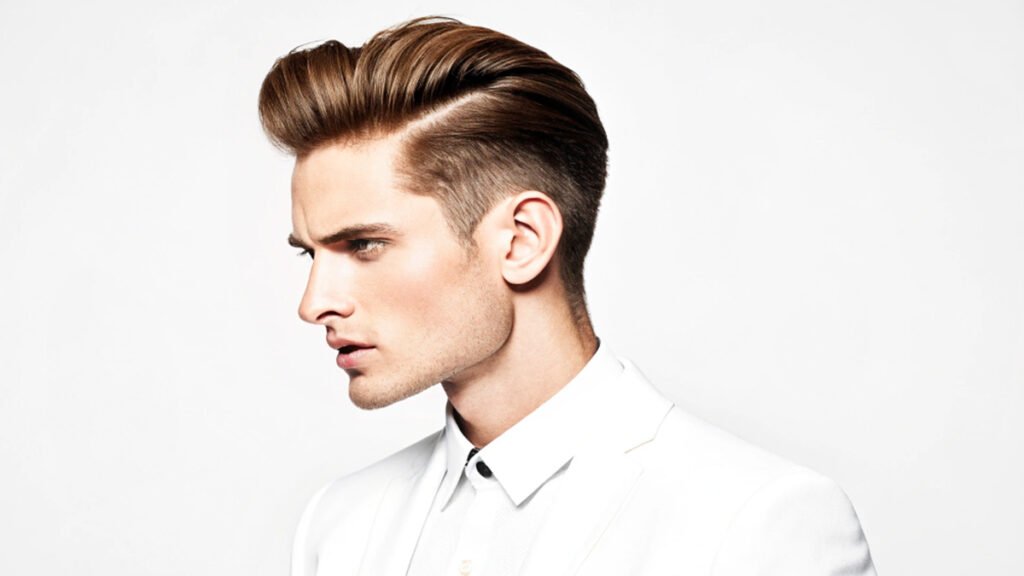
The classic undercut establishes the foundation for all variations. Barbers buzz the sides short while keeping significant length on top. This creates sharp contrast that emphasizes the longer hair section.
Styling options include slicking back for formal occasions or using matte products for casual looks. A full beard adds balance and masculinity to the overall appearance. The classic version works well for men seeking timeless appeal.
Maintenance involves trimming the sides every 2-3 weeks. The top section needs cutting every 4-6 weeks depending on desired length. Regular upkeep preserves the style’s clean lines.
Clean Low Fade Haircut
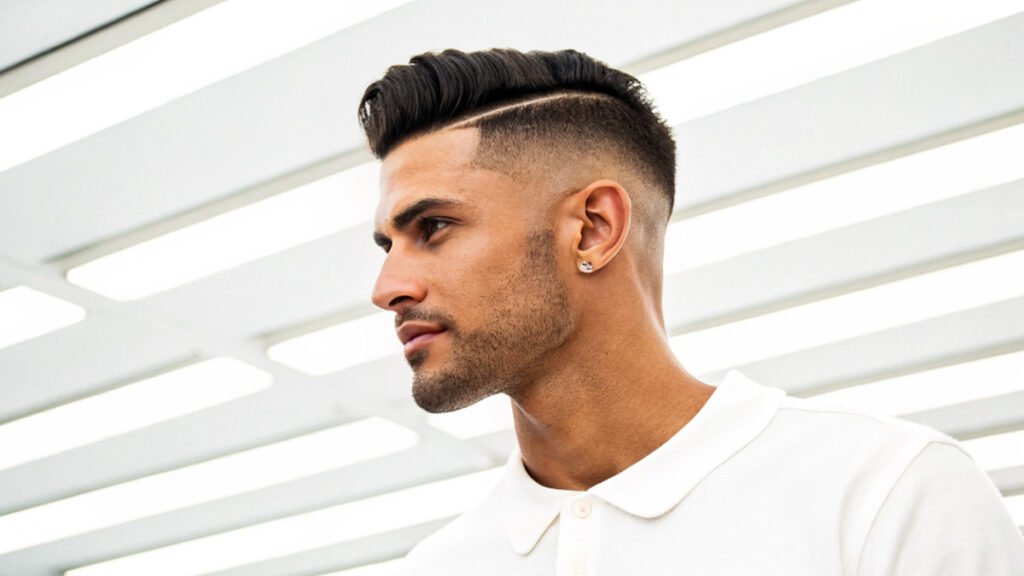
The low fade undercut offers subtle sophistication. Barbers keep more length on the sides, creating gradual transitions. This approach provides a polished look that grows out naturally.
Daily styling requires minimal effort. A simple blow-dry creates volume in the longer top section. Light product application maintains the style throughout the day. This variation suits men who prefer lower maintenance.
Professional settings appreciate the clean low fade’s understated elegance. The style appears neat without being overly dramatic. Business environments often favor this conservative approach.
Classy Taper Fade Undercut
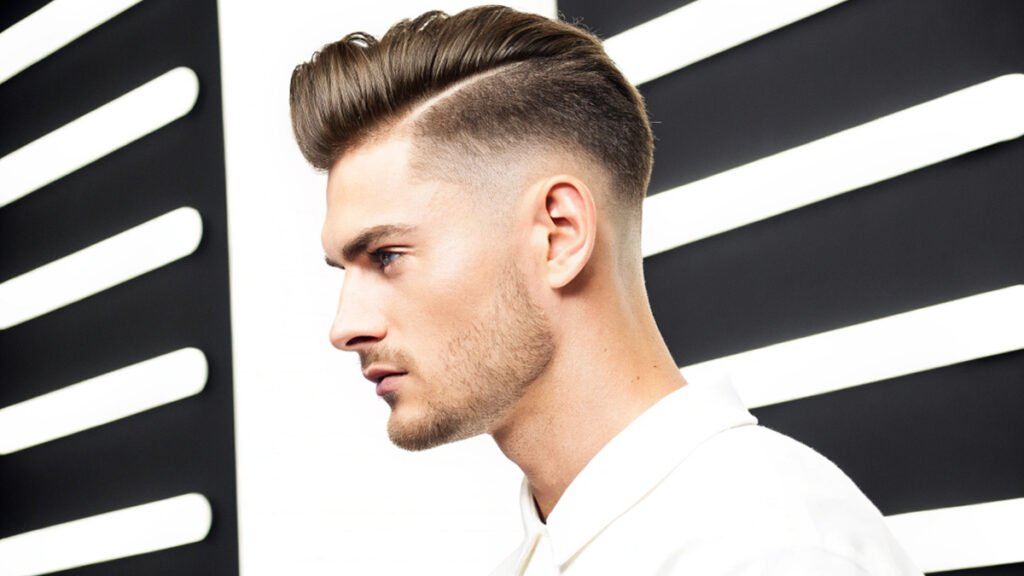
The taper fade undercut combines elegance with modern flair. Barbers gradually blend the sides into shorter lengths while maintaining some length at the edges. This creates sophisticated contrast with the disconnected top section.
Strong-hold styling products work best for slicked-back looks. Fine-tooth combs help achieve smooth, polished styles. This variation suits formal occasions and professional environments.
The tapered approach offers easier maintenance than sharper cuts. Growth appears more natural between appointments. This makes the taper fade ideal for busy professionals.
Edgy High Fade Undercut
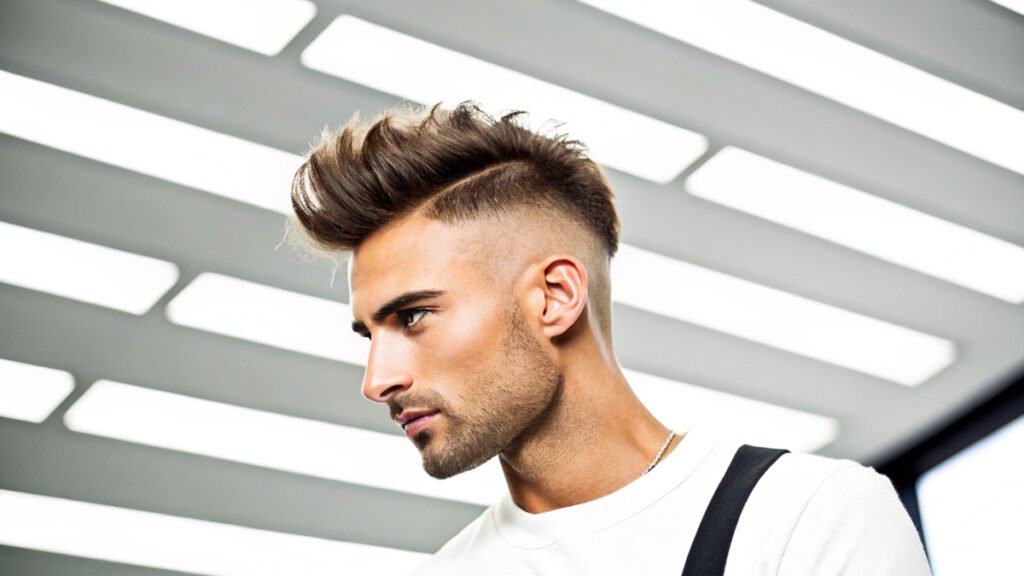
High fade undercuts create bold statements. The fade begins high on the head and blends quickly for sharp contrast. This placement adds attitude and emphasizes stylish personality traits.
Traditional slicked-back styling showcases the dramatic contrast. Adventurous men can experiment with textured quiffs or spiked styles. Strong-hold products maintain these creative variations throughout the day.
This variation requires frequent maintenance. High fades lose definition quickly as hair grows. Plan appointments every 2-3 weeks to preserve the edgy appearance.
Timeless Tapered Undercut
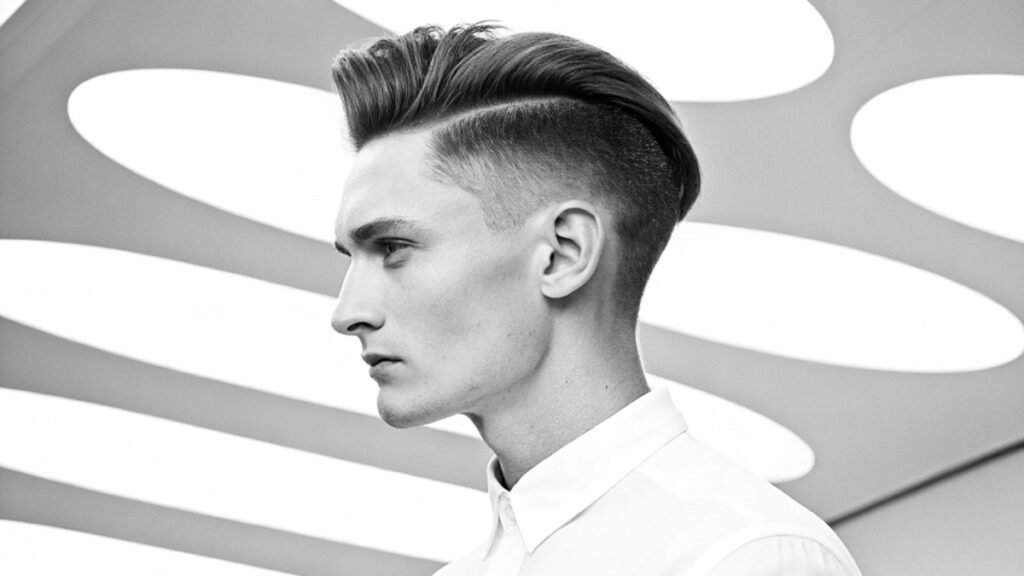
The tapered undercut presents versatile sophistication. Barbers create gradual transitions on the back and sides while maintaining subtle disconnection from the top length. This produces visually appealing yet professional styles.
Smooth tapers blend edge with professionalism. The top section looks impressive when worn sleek, textured, or as voluminous pompadours. Lightweight creams provide relaxed styling options.
Volume creation requires round brushes and blow dryers. Direct airflow upward at the front for impressive lift. This technique enhances the style’s sophisticated appearance.
Disconnected Undercut
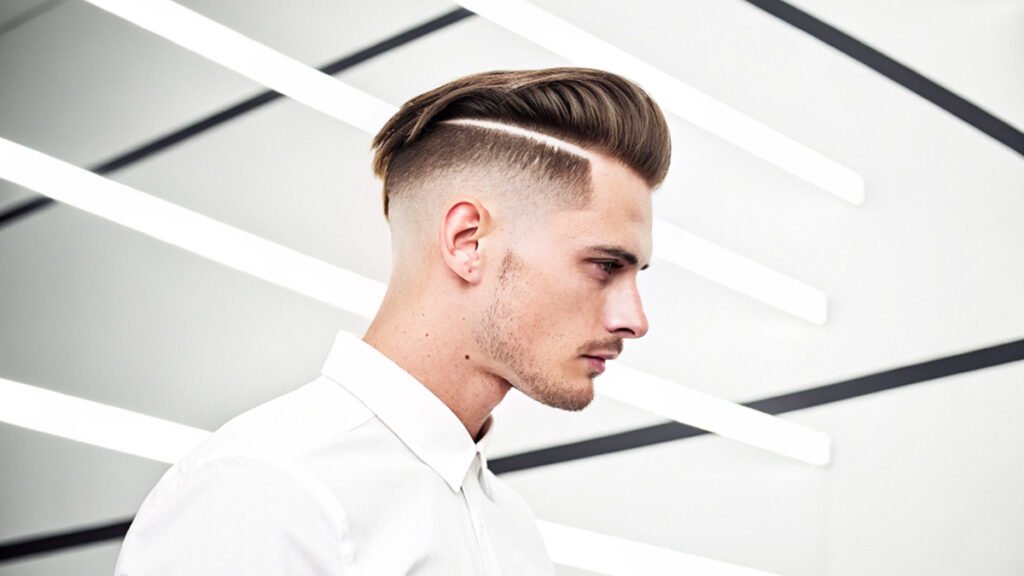
Disconnected undercuts create a provocative contrast. Barbers produce stark length differences that offer powerful, structured appearances. High-contrast looks draw attention upward, flattering round face shapes.
The dramatic styling works well with skin fades or fully buzzed sides. These extreme approaches enhance the style’s bold character. Men seeking a statement look prefer this variation.
Maintenance requires regular attention to preserve sharp lines. The distinct separation becomes more noticeable as hair grows. Schedule frequent trims to maintain the disconnected effect.
Modern Skin Fade Undercut
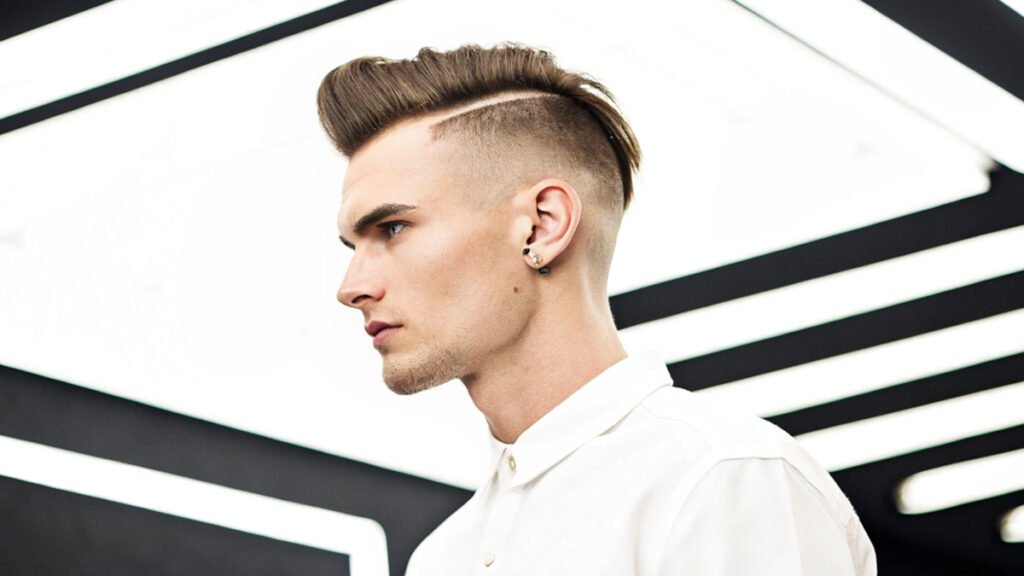
Skin fade undercuts pair sleek tops with shaved sides. The fade blends seamlessly into the scalp, creating a striking contrast. Longer tops allow experimentation with various styling approaches.
Hair powder and matte clay create natural lift and texture. Sea salt sprays provide effortless, tousled appearances. Simple application techniques achieve sophisticated results.
Adding shaved designs showcases personal style. Geometric patterns or simple lines create unique touches. This customization enhances the modern skin fade’s bold character.
Long Hair with Low Taper Fade Undercut
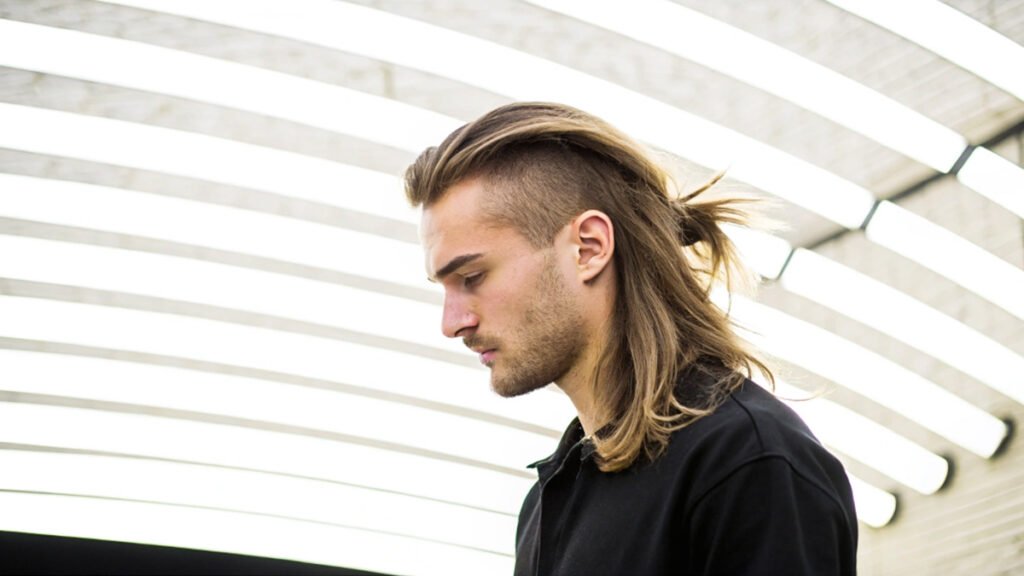
Long hair combinations strike perfect balance between clean and rugged aesthetics. Sharp sides contrast with longer, freer top sections. This approach enhances natural texture and curl patterns.
Taper fades grow out smoothly, requiring less frequent maintenance. The longer top accommodates various styles from waves to slick-backs. This versatility appeals to men seeking adaptive options.
Natural texture enhancement works well with this variation. Men can embrace their hair’s characteristics without intensive upkeep requirements. The style suits active lifestyles.
Balanced Mid Fade Undercut
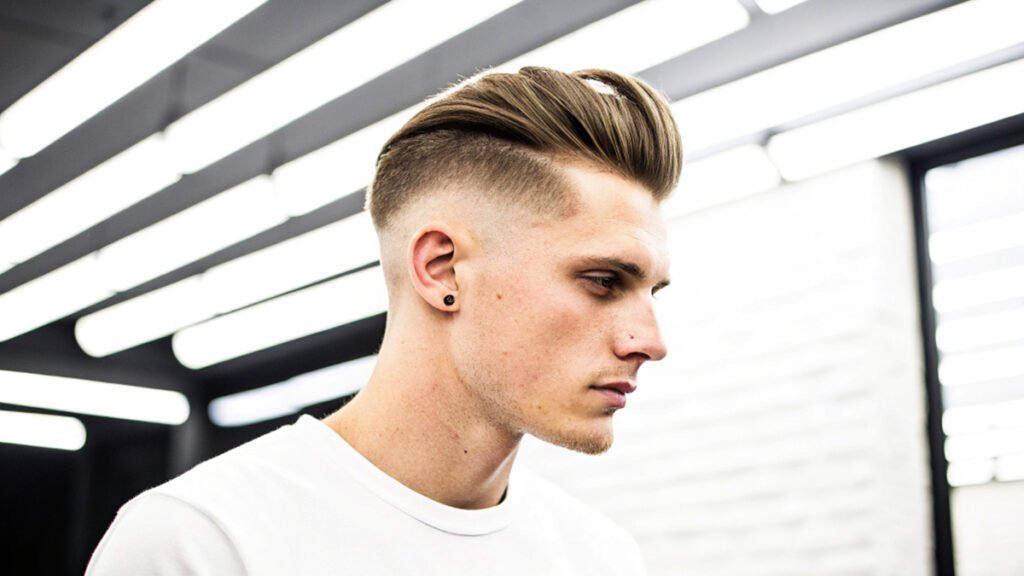
Mid fade undercuts create clean, modern appearances. Natural blending across the back and sides provides fresh feels that balance the undercut’s commanding disconnection. This placement suits most head shapes.
Voluminous pompadours at the front use matte clay for hold. Direct hot airflow upward creates unbeatable volume. Off-duty styling benefits from light creams for messy, textured looks.
The balanced placement makes this variation highly versatile. Professional and casual settings both accommodate mid fade undercuts. This adaptability increases the style’s practical value.
Casual Messy Brush Back with Disconnected Undercut Fade
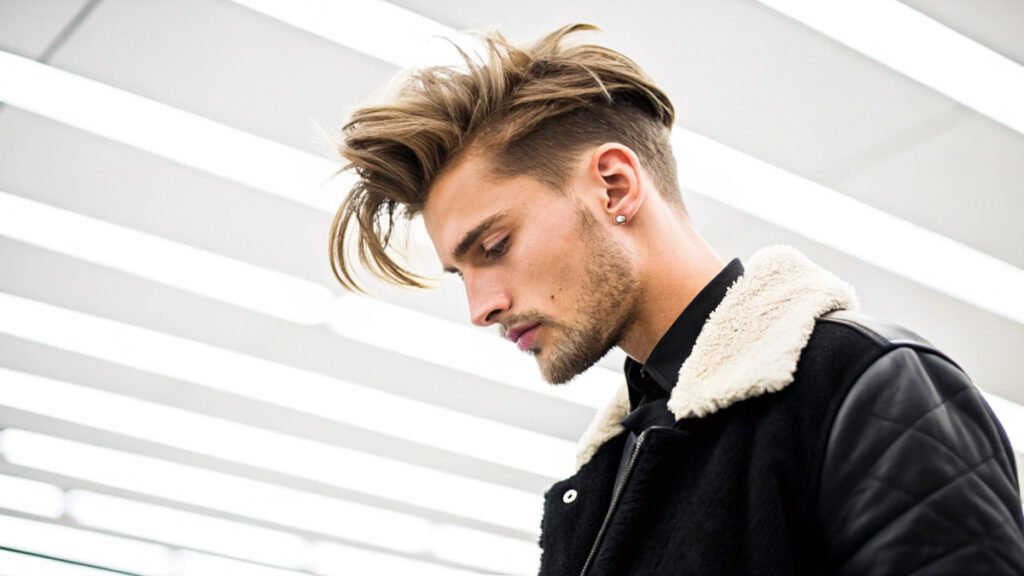
Messy brush backs combine edgy, rugged, and stylish elements. The casual approach creates cool, youthful appearances without gradual blending. Skin or taper faded sides add sharpness and balance.
Pre-styling mousses prepare hair for towel drying. This technique creates undone, casual feels that require minimal effort. The relaxed approach suits laid-back personalities.
Daily maintenance stays minimal with this variation. Quick touches with fingers often suffice for style refresh. This makes the messy brush back ideal for busy lifestyles.
Rebellious Burst Fade Undercut
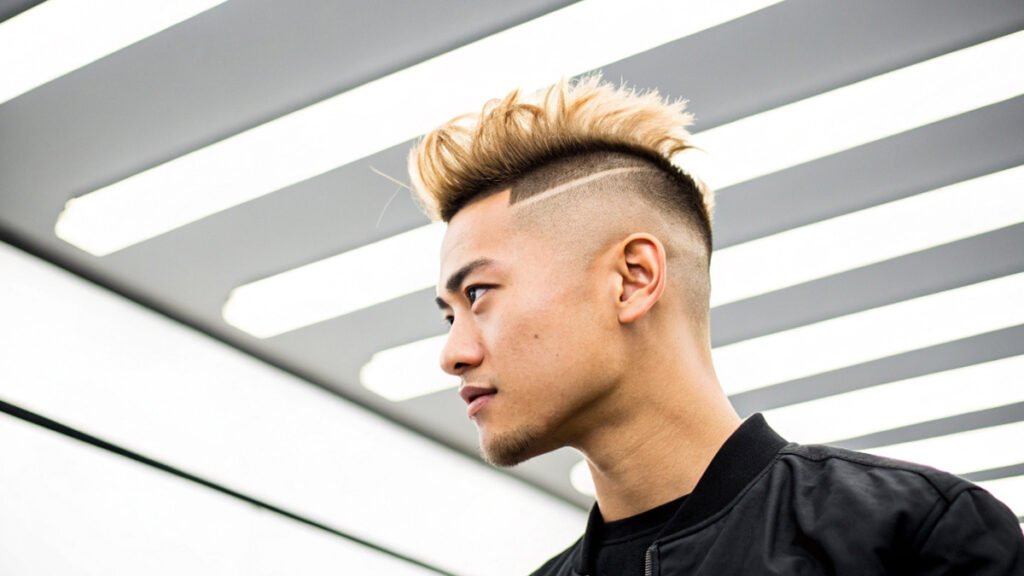
Burst fade undercuts feature curved appearances around the ears with longer tops. This contemporary aesthetic provides smooth blending while offering styling versatility. Various looks work well with this foundation.
Pompadours, mohawks, curly tops, and textured styles all complement burst fades. The curved blending adds head contouring that flatters oval, round, and square faces. This makes the variation widely suitable.
Growing out hair unlocks the burst fade’s full potential. Longer lengths provide more styling options and creative possibilities. Patient clients appreciate the eventual versatility.
Stylish Curly Hair with Faded Undercut
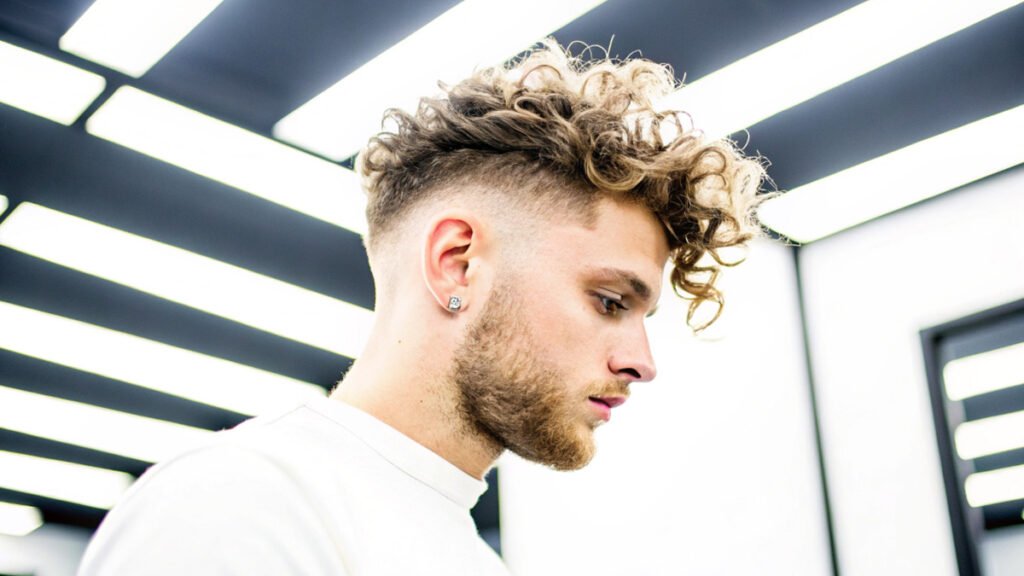
Curly hair gains infinite style with faded undercuts. Natural texture shines while bulk removal from sides creates clean appearances. This combination celebrates natural characteristics while maintaining neat edges.
Light-hold gels and curl-enhancing creams define and control curls. Styling powders create voluminous, messy tops for casual looks. Product selection affects the final texture and appearance.
Regular buzz maintenance preserves the high-contrast feel. Consistent undercut trimming maintains preferred fade levels. This attention keeps the style looking sharp and intentional.
Daring Mohawk Undercut Fade
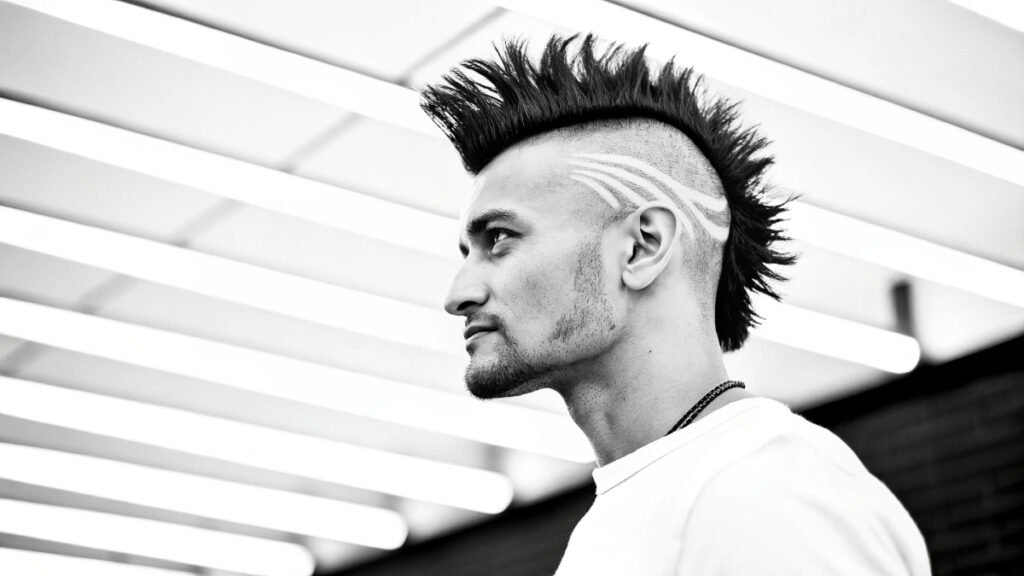
Mohawk undercuts combine classic hawk appeal with fade crispness. High-contrast looks feature striking, disconnected feels that make bold statements. Skin or high fades blend into the scalp for daring aesthetics.
The mohawk strip offers various styling options. Polished slick-backs provide sophisticated approaches. Strong-hold gels create iconic, spiked finishes for dramatic effects.
This variation demands confidence and commitment. The bold appearance draws attention in all settings. Consider lifestyle compatibility before choosing mohawk undercuts.
Trendy Man Bun with Low Temp Fade Undercut
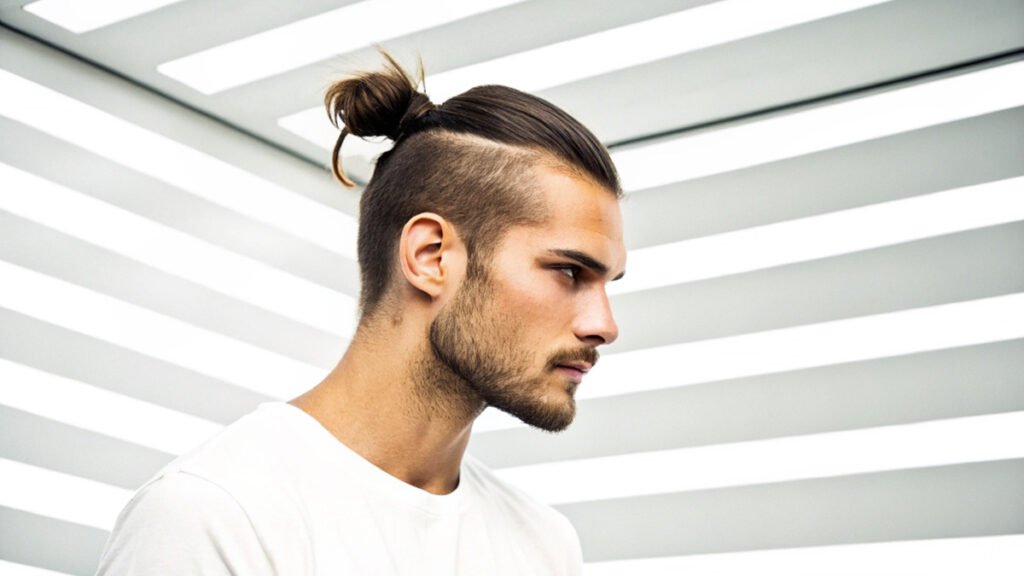
Low temp fade undercuts highlight man buns through clean, structured appearances. Relaxed and trendy vibes result from temple fading that creates smooth transitions against undercuts.
Hair length requirements include at least six inches for sleek buns. Hair creams enable slicked-back bun styles. Half-up buns with loose face-framing strands offer casual alternatives.
Temple fading specifically targets the hairline area. This precise technique requires skilled barbers who understand facial structure. Proper execution enhances the overall style balance.
Textured Pompadour with Undercut Drop Fade
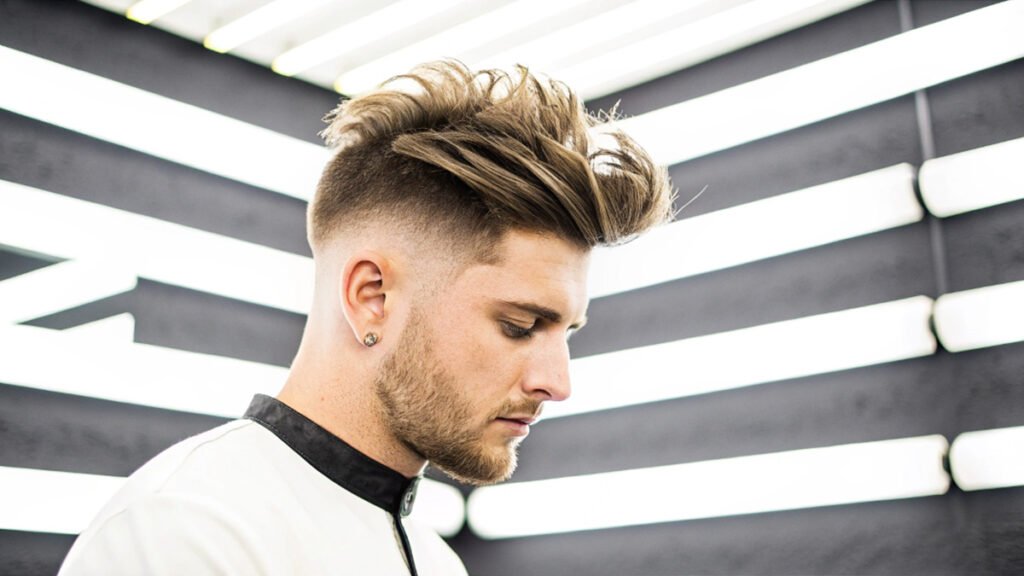
Textured pompadours paired with undercut drop fades combine classic volume with contemporary coolness. Clean but voluminous styles result from this sophisticated combination.
Pompadours bring presence, height, and vintage charm to modern styles. Dropped shapes around ears pull focus to the top section. Meticulous, well-groomed beards complement this refined look.
The drop fade technique requires advanced barbering skills. Barbers must understand how to create the curved, dropped shape. This technical precision affects the final result quality.
Fresh Mid Undercut Fade with Cool Design
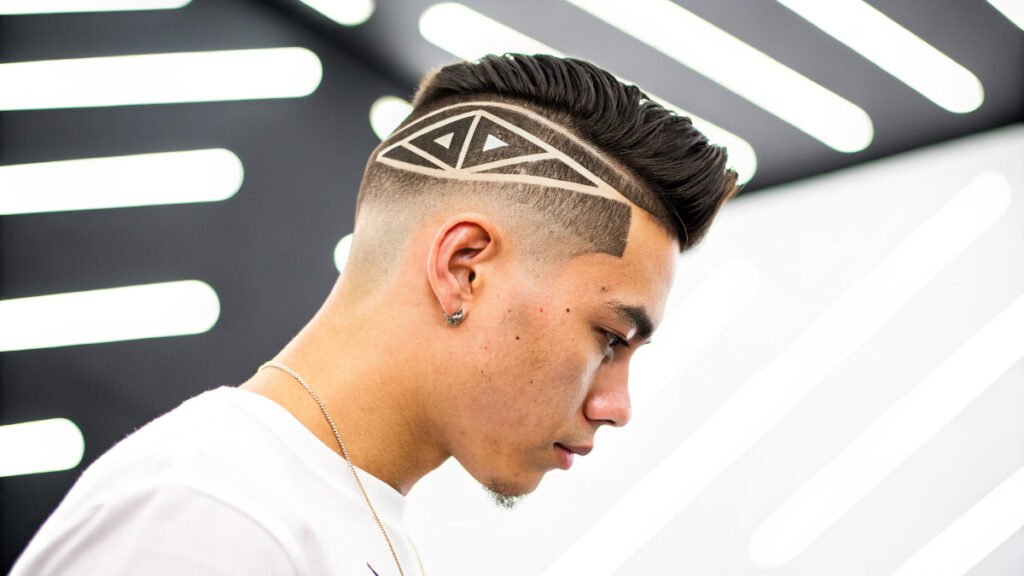
Mid undercut fades offer balanced, bold looks that accommodate personal customization through cool designs. Unique styles result from creative pattern incorporation.
Man buns pair perfectly with smooth fades, showcasing temple transitions. Geometric patterns, custom artwork, initials, and simple slashed lines provide interesting shaving options.
Design selection should reflect personal style and lifestyle requirements. Professional environments may limit design complexity. Consider long-term preferences when choosing permanent design elements.
Hipster Faux Hawk with Undercut Fade and Beard
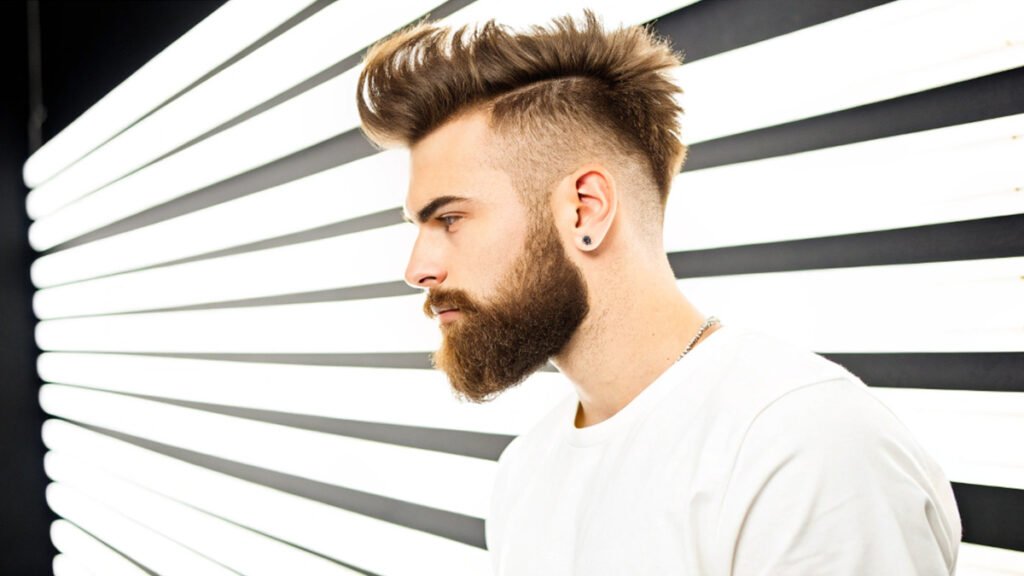
Faux hawks fused with undercut fades and beards bring rugged flair to contemporary styles. Voluminous, hipster aesthetics result from this combination that avoids completely shaved sides.
Strong-hold pomades and waxes create slick styles. Light styling pastes build effortless, tousled effects that complement full beards. Product choice affects the final texture and hold level.
The hipster aesthetic requires attention to overall grooming. Beard maintenance must coordinate with haircut schedules. This comprehensive approach creates cohesive appearances.
Advanced Styling Techniques and Methods
Volume Creation Strategies
Professional blow-drying techniques significantly impact final results. Direct airflow against natural growth patterns for maximum volume. Round brushes help achieve smooth textures and controlled shapes.
Product layering adds depth and dimension to styles. Foundation products like mousses or salt sprays prepare hair. Styling products provide control and finishing touches. This systematic approach creates lasting, dimensional looks.
Different styles require specific application methods. Messy looks need strategic product placement in key areas. Sleek styles demand even product distribution throughout the hair. Practice improves technique execution and results.
Heat Styling Applications
Blow dryers create volume and direction in undercut styles. Use lower heat settings to prevent damage. Concentrate airflow on specific sections for targeted results.
Flat irons help achieve sleek, controlled finishes. Apply heat protectant products before styling. Work in small sections for even heat distribution and optimal results.
Curling tools can add texture and movement to longer top sections. Choose barrel sizes based on desired curl tightness. Allow curls to cool completely before separating for lasting results.
Product Combination Techniques
Pre-styling products prepare hair for final styling. Heat protectants shield hair from thermal damage. Volumizing mousses create foundation for lifted styles.
Primary styling products provide hold and control. Pomades offer shine and structure. Clays provide matte finishes with strong hold. Creams give natural looks with moderate control.
Finishing products add final touches and details. Hairsprays lock styles in place. Shine sprays add glossy finishes. Texture sprays enhance movement and dimension.
Professional Maintenance Schedules
Weekly Care Routines
Daily washing may strip natural oils from hair. Most men benefit from washing every 2-3 days. Use quality shampoos formulated for your hair type.
Conditioning treatments maintain hair health and manageability. Focus conditioner on mid-lengths and ends. Avoid applying conditioner directly to the scalp area.
Weekly deep conditioning treatments restore moisture and strength. Leave-in treatments provide ongoing protection. These steps maintain hair quality between cuts.
Monthly Barbershop Appointments
Schedule regular appointments every 3-4 weeks for optimal maintenance. Fades lose definition quickly and require frequent touch-ups. Consistent scheduling prevents overgrowth issues.
Communicate style preferences clearly with your barber. Bring reference photos for accuracy. Discuss any changes or adjustments you want to make.
Ask about home maintenance tips during appointments. Professional advice helps extend style longevity. Learn proper product application techniques from experienced barbers.
Seasonal Adjustments
Summer humidity affects styling product performance. Use lighter products in humid conditions. Anti-frizz formulations help combat moisture-related issues.
Winter dryness requires additional moisture protection. Use leave-in conditioners and hydrating treatments. Protect hair from harsh weather conditions with appropriate products.
Seasonal color changes can enhance undercut fades. Subtle highlights add dimension to longer top sections. Consult colorists about options that complement your cut.
Hair Type Considerations and Adaptations
Fine Hair Optimization
Fine hair benefits from volume-enhancing products and techniques. Lightweight formulations prevent weighing down delicate strands. Root-lifting products create foundation for fuller appearances.
Blow-drying techniques matter more for fine hair. Use round brushes to create lift at the roots. Direct airflow upward for maximum volume enhancement.
Avoid heavy products that flatten fine hair. Oil-based formulations can weigh down delicate strands. Choose lightweight alternatives that provide hold without heaviness.
Thick Hair Management
Thick hair requires stronger control products for management. Heavy-duty formulations tame unruly textures. Professional-grade products often work better for thick hair types.
Thinning techniques during cutting help manage bulk. Barbers can reduce thickness without compromising style integrity. This makes styling easier and more manageable.
Layer cutting adds movement to thick hair. Strategic layering prevents triangular shapes. Proper technique enhances the undercut’s contrast and visual impact.
Curly Hair Enhancement
Curly hair benefits from moisture-rich products. Curl-defining creams enhance natural patterns. Avoid products with sulfates that can strip natural oils.
Diffusing techniques preserve curl patterns during drying. Use low heat and gentle airflow. Scrunch hair gently while drying for defined curls.
Regular deep conditioning maintains curl health and definition. Protein treatments strengthen curl structure. This prevents frizz and maintains shape integrity.
Straight Hair Styling
Straight hair showcases clean lines effectively. The natural smoothness emphasizes fade precision. Minimal product often achieves sophisticated results.
Texture creation adds interest to straight hair. Salt sprays and texture powders provide grip and movement. These products prevent flat, lifeless appearances.
Heat styling tools work well on straight hair. Flat irons create sleek finishes. Curling tools add temporary texture and movement for variety.
Face Shape Compatibility Analysis
Round Face Optimization
Round faces benefit from height and vertical emphasis. Taller styles elongate facial proportions. Higher fades create upward movement that flatters round shapes.
Avoid wide styles that emphasize roundness. Side parts add asymmetry that breaks circular shapes. Textured tops provide visual interest without adding width.
Beard combinations can enhance jawline definition. Structured facial hair creates angles that balance round features. Coordinate beard and hair maintenance for optimal results.
Square Face Balancing
Square faces work well with softer, textured tops. Harsh lines can emphasize angular features. Gentle textures provide flattering contrast to strong jawlines.
Mid to low fades complement square faces better than high fades. Lower fade placement doesn’t emphasize the jawline as dramatically. This creates better overall balance.
Side-swept styles soften angular features. Asymmetrical elements break up geometric shapes. These techniques create more flattering overall proportions.
Oval Face Versatility
Oval faces accommodate most undercut fade variations successfully. Balanced proportions work with various style approaches. This face shape offers maximum styling flexibility.
Experiment with different fade heights and top lengths. Oval faces can handle dramatic contrasts effectively. Try various styling approaches to find personal preferences.
Both formal and casual styling approaches work well. Professional slicked-back styles and casual messy looks both flatter oval faces. This versatility increases style options.
Long Face Considerations
Long faces benefit from width-adding techniques. Textured sides and fuller tops create horizontal emphasis. Avoid styles that add excessive height.
Lower fade placements work better than high fades. Extra length on the sides balances facial proportions. This prevents emphasizing length unnecessarily.
Beard additions can shorten facial appearance. Full beards add visual weight to the lower face. This helps balance long facial proportions effectively.
Professional Environment Adaptations
Corporate Styling Approaches
Conservative corporate environments favor subtle undercut variations. Low fades and longer tops maintain professional appearances. Clean, polished styling works best in formal settings.
Product selection affects professional suitability. Matte finishes appear more conservative than high-shine looks. Natural-looking styles integrate better in traditional business environments.
Maintenance schedules matter in professional settings. Keep cuts fresh with regular appointments. Overgrown styles can appear unkempt in conservative environments.
Creative Industry Flexibility
Creative environments often embrace bold undercut variations. High fades and dramatic contrasts suit artistic fields. Unique styling approaches can enhance creative credibility.
Design elements add personal expression opportunities. Shaved patterns and artistic details showcase creativity. These additions align with creative industry cultures.
Color experimentation works well in creative settings. Subtle highlights or bold color choices complement artistic environments. Consult colorists about options that enhance your undercut.
Service Industry Practicality
Service industries require practical, low-maintenance styles. Styles that withstand physical activity work best. Easy touch-up capabilities matter during busy work periods.
Sweat resistance becomes important in active service roles. Products that maintain hold despite perspiration work better. Waterproof formulations provide all-day reliability.
Quick styling routines suit demanding schedules. Styles that look good with minimal daily effort reduce morning preparation time. This practicality benefits busy service workers.
Troubleshooting Common Issues
Growth Management Strategies
Awkward growth phases challenge undercut maintenance. Plan transition strategies before growth becomes problematic. Intermediate cuts help manage difficult periods.
Product adjustments help during growth phases. Different lengths require different styling approaches. Adapt techniques as hair grows and proportions change.
Patience during growth periods prevents hasty decisions. Resist urges to cut everything off during challenging phases. Proper planning makes growing out more manageable.
Styling Problem Solutions
Product buildup affects styling performance. Regular clarifying treatments remove excess product residue. This restores hair’s natural texture and responsiveness.
Uneven fades require professional correction. Attempt home fixes often worsen problems. Schedule correction appointments with experienced barbers promptly.
Styling difficulties may indicate wrong product choices. Experiment with different formulations to find optimal matches. Consider hair changes that affect product performance.
Maintenance Scheduling Challenges
Busy schedules challenge regular maintenance routines. Plan appointments in advance to secure preferred time slots. Consistent scheduling prevents style deterioration.
Budget constraints may limit professional services. Learn basic maintenance techniques for home care. Invest in quality tools for better home styling results.
Travel disruptions affect maintenance schedules. Research barbershops in travel destinations. Pack travel-sized styling products for consistency away from home.
Cost Analysis and Budgeting
Initial Investment Considerations
Quality haircuts require skilled barbers who charge appropriate fees. Budget for cuts every 3-4 weeks to maintain optimal appearance. Factor this recurring cost into grooming budgets.
Professional styling products cost more than drugstore alternatives. Invest in quality formulations that provide better results. Calculate monthly product costs for budget planning.
Styling tools represent one-time investments. Quality blow dryers and styling tools last years with proper care. Consider these purchases as long-term investments.
Ongoing Maintenance Costs
Regular barbershop visits represent the largest ongoing expense. Establish relationships with reliable barbers for consistent service. Some shops offer package deals for regular clients.
Product replacement costs vary by usage frequency. Heavy product users replace supplies more often. Buy larger sizes for better value when possible.
Occasional professional treatments add to maintenance costs. Deep conditioning and scalp treatments benefit hair health. Budget for these services quarterly or seasonally.
Value Optimization Strategies
Learn basic maintenance techniques to extend time between professional cuts. Simple touch-ups can add days to professional cuts. This reduces overall maintenance frequency.
Buy products during sales and promotions for savings. Stock up on frequently used items when prices drop. This reduces average product costs over time.
Consider loyalty programs at preferred barbershops. Many shops offer discounts for regular clients. These programs can reduce long-term maintenance costs significantly.
Future Trends and Evolution
Emerging Style Variations
Contemporary barbers continue developing new undercut fade variations. Social media platforms showcase innovative techniques and approaches. Stay current with evolving trends through professional sources.
Technology influences cutting techniques and styling methods. New tools enable more precise cuts and creative possibilities. Professional barbers adopt these advances to improve service quality.
Cultural influences shape style preferences and acceptance. Global communication spreads trends rapidly across regions. Local preferences still influence style adaptation and modification.
Product Innovation Impacts
New product formulations improve styling capabilities and hair health. Advanced ingredients provide better performance with less damage. Research new products to enhance styling results.
Sustainable and natural products gain popularity among conscious consumers. Eco-friendly formulations offer performance without environmental impact. Consider these options for responsible grooming choices.
Customizable products allow personalized styling solutions. Made-to-order formulations address specific hair needs. These services represent premium options for optimal results.
Industry Development Trends
Barbershop culture continues evolving with changing social preferences. Modern shops offer comprehensive grooming services beyond basic cuts. This expansion provides convenient, full-service options.
Education and certification standards improve service quality across the industry. Better-trained barbers provide superior results and customer experiences. Choose certified professionals for optimal service.
Technology integration enhances appointment scheduling and service delivery. Online booking and consultation services improve convenience. These advances make professional grooming more accessible.
Conclusion and Final Recommendations
The undercut fade remains a premier choice for men seeking versatile, stylish haircuts. This comprehensive guide provides the information needed to choose, achieve, and maintain your ideal variation. Success depends on proper planning, skilled execution, and consistent maintenance.
Select variations that align with your lifestyle, face shape, and professional requirements. Work with experienced barbers who understand your goals and preferences. Invest in quality products and tools for optimal home maintenance.
Regular maintenance schedules preserve style integrity and appearance quality. Plan appointments in advance and budget appropriately for ongoing costs. Learn basic techniques to extend professional cut longevity.
Remember that great undercut fades result from collaboration between skilled barbers and informed clients. Use this guide as a foundation for discussions with your barber. Together, you can achieve and maintain the perfect undercut fade for your individual needs and preferences.
The time invested in understanding undercut fades pays dividends in confidence and appearance quality. Apply these insights to create a signature style that enhances your personal brand and professional image. Your perfect undercut fade awaits your commitment to excellence in grooming and style.
